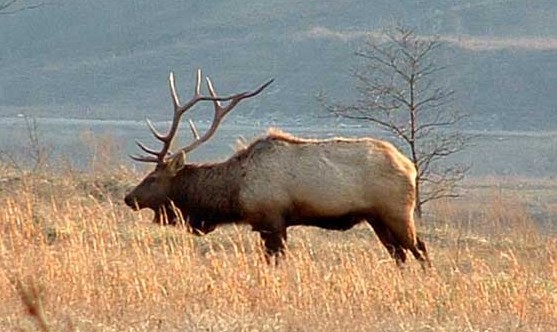LOGAN, W.Va. — The West Virginia Division of Natural Resources is ready to push forward with the reintroduction of elk in the Mountain State. The plan calls for the reintroduction in southern West Virginia.
“The southern coalfields have the least amount of suitable habitat,” said DNR Director Frank Jezioro citing a 2005 habitat study of the state by Syracuse University. “But, they there is no farming and no crop damage problems down there and the people would accept it. Plus we know Kentucky has had success with similar land and we knew this was the first place to start looking.”
The last wild elk killed in West Virginia was around 1875 in Webster County. More recently there have been confirmed sightings of elk in southern West Virginia, most of which are attributed to elk from the reintroduced herd in Kentucky making their way across the Tug Fork River.
Kentucky’s successful reintroduction of elk in the 1990’s fueled the idea in West Virginia. Governor Earl Ray Tomblin is on board and wants to see the program move ahead.
However, there are key hurdles to cross before the first bugles can be heard echoing through the hills and hollows again.
“Our guys have identified five or six counties down there where they felt elk could be reintroduced,” said Jezioro on Ram Trucks West Virginia Outdoors. “You need something in the area of 30,000 to 40,000 acres.”
A tract of land of adequate size in southern West Virginia can only be found in a private holding. Jezioro said the program in southern West Virginia will hinge on a willing land owner, likely a larger corporation, which is ready to enter an agreement to permanently allow public access to the property.
“If you’re going to use hunters’ license money, you can’t put these elk on private land unless you have an agreement the hunters are going to have to have access to them,” said Jezioro. “Hopefully we’ll be able to find a large landowner down there that’s willing to do that. Everybody seems to think we surely will.”
Should that not happen, Jezioro said the state isn’t going to give up the idea. The Syracuse study identified the Monongahela National Forest as the top habitat for reintroduction because of the size of contiguous acreage. The National Forest encompasses roughly one Million acres. However, the drawback has been the historic concerns of farmers in the South Branch Valley about crop damage.
“If that doesn’t happen, then we would consider putting them in the northern mountains,” Jezioro explained. “But if we did decide to put them in the northern mountains, the first thing we would do is have a public meeting to see if the public would want them. If they don’t, there’s no need to pursue it any further.”
Another significant hurdle will be getting the elk. Kentucky is the most likely place to get the stock to introduce to West Virginia. The herd there has been disease free since its introduction in the 1990’s. However, there is a waiting list of states to buy elk from Kentucky and West Virginia sits about fourth on that list. Kentucky has tightened up on the number of elk it lets go annually because of pressure from hunters in their own state wanting to hunt them.
Once those hurdles are cleared, look for a period of at least 15 to 20 years before a West Virginia elk herd reaches a point where hunting could be allowed on a limited basis.
“A lot of people have the wrong idea about elk stocking,” Jezioro said. “They think of it as trout stocking, where you release a thousand elk from a truck and everybody starts hunting. That’s not how it works.”
The driving factor behind the elk reintroduction, not surprisingly, was money. Kentucky and Pennsylvania have each enjoyed a windfall from their programs. Kentucky has a non-refundable fee for hunting permit applications and typically receives 45,000 applications every year for a few hundred permits. Pennsylvania developed an elk viewing area and books tour buses of groups wanting to get a glimpse of the beasts in the wild.
“This is a long term program,” said Jezioro. “It’s an economic benefit to any state where you can establish an elk herd, Kentucky and Pennsylvania have found this, but you have to have an area where you can put them and make it accessible to the public.”

